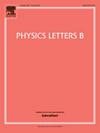Revisiting the proton-antiproton scattering using a constituent-quark-model based coupled-channels calculation
IF 4.3
2区 物理与天体物理
Q1 ASTRONOMY & ASTROPHYSICS
引用次数: 0
Abstract
Motivated by the last experimental and theoretical advances in the analysis of possible baryonium resonances, the and their partners, we perform a constituent-quark-model based coupled-channels calculation of the proton-antiproton scattering in order to analyze the possible existence of bound states or near-threshold structures. The used potential is derived from a G-parity transformation of the quark-model-based NN interaction which has described well deuteron properties, NN phase shifts, and even hadron-hadron phenomenology. The additional annihilation is taken into account by a complex phenomenological potential whose real part is generated by one-pion and one-gluon exchange annihilation potentials and its imaginary part is an energy-independent potential of Gaussian form. Then, all the parameters of the interaction are constrained by the NN sector except those determining the imaginary part of the annihilation potential. Our study concludes that the nucleon-antinucleon dynamics is complex and rich in scattering singularities near the proton-antiproton and neutron-antineutron thresholds.
求助全文
约1分钟内获得全文
求助全文
来源期刊

Physics Letters B
物理-物理:综合
CiteScore
9.10
自引率
6.80%
发文量
647
审稿时长
3 months
期刊介绍:
Physics Letters B ensures the rapid publication of important new results in particle physics, nuclear physics and cosmology. Specialized editors are responsible for contributions in experimental nuclear physics, theoretical nuclear physics, experimental high-energy physics, theoretical high-energy physics, and astrophysics.
 求助内容:
求助内容: 应助结果提醒方式:
应助结果提醒方式:


